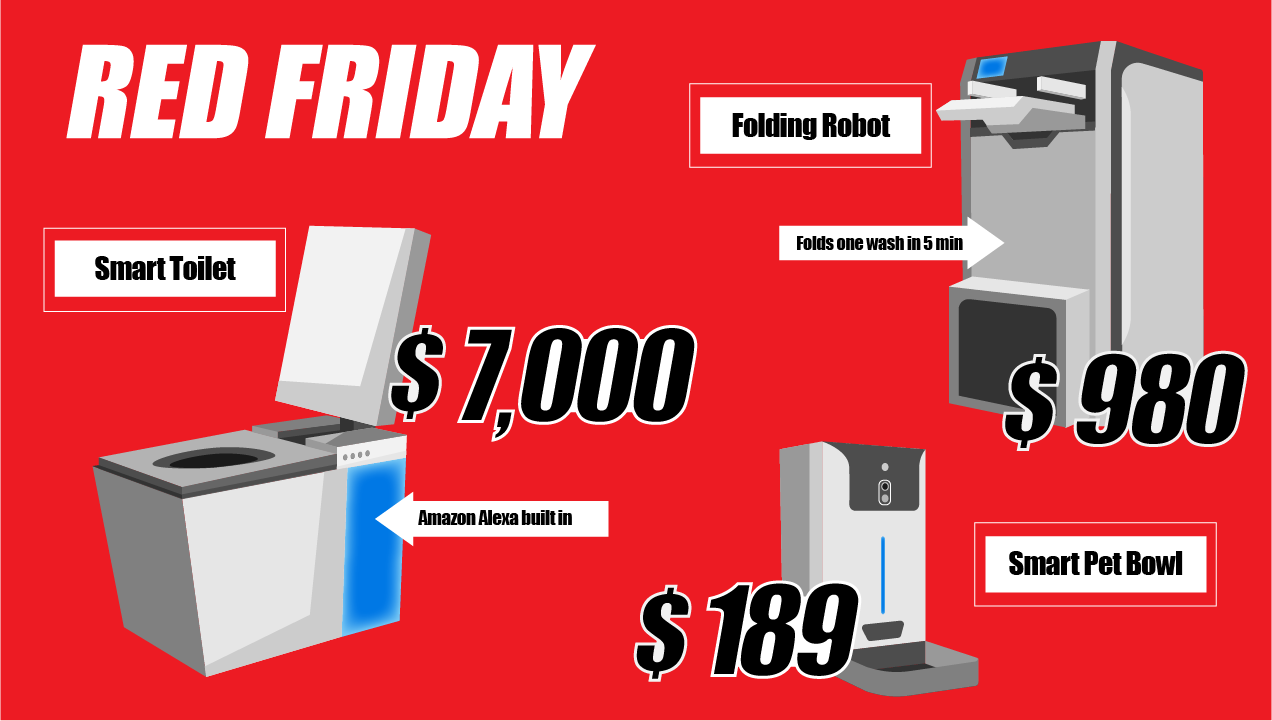Design Red Herrings: The Fashion Show Effect
Every year it seems that we catch a distinctly familiar – and fishy – smell wafting around a number of high profile product launches and demonstrations. It is the unmistakable aroma of a migratory species that is attracted to large events full of hype, hyperbole and razzmatazz, the infamous red herring. They aren’t always easy to spot. Red herrings can be extremely high quality and impressive in terms of both ingenuity and their use of cutting-edge technology. However, in design terms, these products are not what they appear to be, i.e. genuinely useful or intended for serious public consumption.

Images by Sonja Kozik
Spotting red herrings – the three lenses test
We have developed a framework for assessing new products and technologies in the Labs, which is very handy for spotting design red herrings. Red herrings generally lack the following qualities, which can be described as three lenses that all successful innovations have to be visible through.
1. Human need
This is the essential starting point for user-centered design, design thinking, and sustainable product design. It’s the point where we identify a problem that needs to be solved and start to explore tech solutions. This is the lens through which, for example, a caveman saw a need for a way to shift stuff from a to b that was easier than carrying it. So begins the long process of designing solutions, like domesticating wild donkeys to carry stuff, experimenting with sleds, or rolling stones on logs to your local henge.
2. Equipment
Once the human need – or problem that needs solving – is clearly defined and solutions are visible, humans need to see those solutions through a different lens. They see methods to equip themselves with tools to accomplish their goals. The wheel, for example, becomes the tool that we equip ourselves with to help us move stuff around. Our equipment can also be combined: take a tamed donkey, a sled that used to roll along on logs, attach them together and add wheels and you are fully equipped with an animal-powered cart.
3. Enabling
Of course, once you’ve identified the need, and equipped yourself with the necessary tools and innovations to solve your human problem, successful technologies have to be viewed through a third lens: enabling new human experiences. So, in our early human scenario, once there’s a donkey pulling your cart, can you see it enabling you to do more? Like growing more food than you can personally consume and trading the surplus crops with other cart-enabled people?
So, hey presto, the need for early man to shift heavy stuff about (lens 1) becomes the driving force to invent transportation (lens 2), which in turn creates new ideas like trade (lens 3). Lens 1 is discovering the human need, lens 2 is equipping ourselves with tools to meet the need, and lens 3 is enabling new, valuable experiences through the tools we create.
Let’s take this 3-lens framework and look at some of the headline items we’ve seen this year. Are they red herrings?
Flushed away?
Much attention was paid to a voice-enabled toilet back at CES in January. There was clearly talent in the engineering, automatically lifting the seat, mood lighting, the ability to perform all the expected toilet pan functions with a voice command. However, what is the human need being addressed here?
- Is hands-free operation useful in a toilet? Yes, but we’ve had self-flushing, light sensor automation on public toilets and washbasin taps for decades. So, the talking AI loo needs to do more than that, surely?
- Mood lighting? Playing music on demand? It’s not the most hygienic place to chill out, is it? It’s not a leisure location, unless you use the loo for listening to music while you are in the bath or something like that. In which case, why not make the bath voice activated?
- Automated lifting of the lid? That appears useful at first, but is it? Lifting the lid is a preference, it’s also hit and miss in homes with young children, teens, multiple users with different habits. And they wash their hands anyway (hopefully) so touching the seat isn’t a hygiene issue. So, what problem does it solve? The problem of lifting up the loo seat, which isn’t really a problem in the first place.
When is a door not a door?
Also featured at CES was a rather complex, but nevertheless impressively engineered, expanding door that facilitates deliveries being made when you are out of your house. The smart door expands with secure storage spaces built into it. Now this clearly meets a human need for securing your parcel deliveries, but not so much for working as a door. A door needs to open, easily and quickly, in a variety of circumstances where you need the full width of the doorway (with bags, shopping, kids, babies, prams, old people with limited mobility, wheelchair access, escaping a fire etc.). Presumably this is why, after thousands of years of doors, and hundreds of years of postal services, we’ve never really gone beyond doors with a letterbox, and possibly a small letter basket on the other side to stop your dog from eating the junk mail.
Say meow?
A smart food bowl that scans and recognizes your cat’s unique features, and ensures only your cat’s face can unlock the secured food compartment? Clever tech, sure, but is that really solving a human need more than, say, securing the cat’s access to the food area, or changing the feeding routine to prevent stray cats from accessing the bowl? Or anything else billions of cat owners have done for thousands of years without there being a clear demand for biometric cat bowls? No.
The fashion show effect
These products are hugely competent – technically – and the engineer in me is impressed, but they are not sustainable designs. They are more like a proof of concept, designed to show how much tech can be packed into a certain shape, or form, and showcasing the potential applications for enhancing products with technology.
These high profile, headline-grabbing red herring products are very much like the fashion shows of avant garde new designers. In 2018 at Milan there was a much reported Krizia show with completely see-through clothing; another show in London featured models with multiple, prawn-like extra legs on their trousers. This is nothing new. When I was in my teens Jean Paul Gaultier was hitting the headlines by putting men in transparent lampshade mini-skirts. The conceptual, artistic element of fashion shows serve an important industry function, they shine a spotlight on new designers, who get hired by fashion houses and high street brands to shape the clothing collections we’ll all be wearing someday.
The voice toilet might never take off, but a major bathroom furniture brand might well acquire the same tech talent to develop more useful voice applications for the bathroom.
In the same way, the technological red herrings at shows like CES bring crowdfunded tech talent and venture capital-backed innovators into contact with major manufacturers. The voice toilet might never take off, but a major bathroom furniture brand might well acquire the same tech talent to develop more useful voice applications for the bathroom. The expanding door might not work for consumers, but maybe a security firm will adapt the tech for large scale warehouse security doors. Even the facial recognition cat bowl might provide new layer of identification for pet IDs and passporting.
The red herring product is a strategy for getting noticed, which is no bad thing – we all want to be noticed – but getting noticed is not a design philosophy. If it was, presumably I’d be writing this wearing a transparent lime green mini-skirt… in a beautifully mood-lit lavatory.
—-
The red herring might not be useful when it’s grabbing the headlines, but it can evolve into a really effective innovation when it’s put into the right environment. In part 2 of Design Red Herrings we’ll look at other species of red herring: the product that lacks an ecosystem and the product design mindset that draws a distinction between physical products and the services they need to become sustainable.
